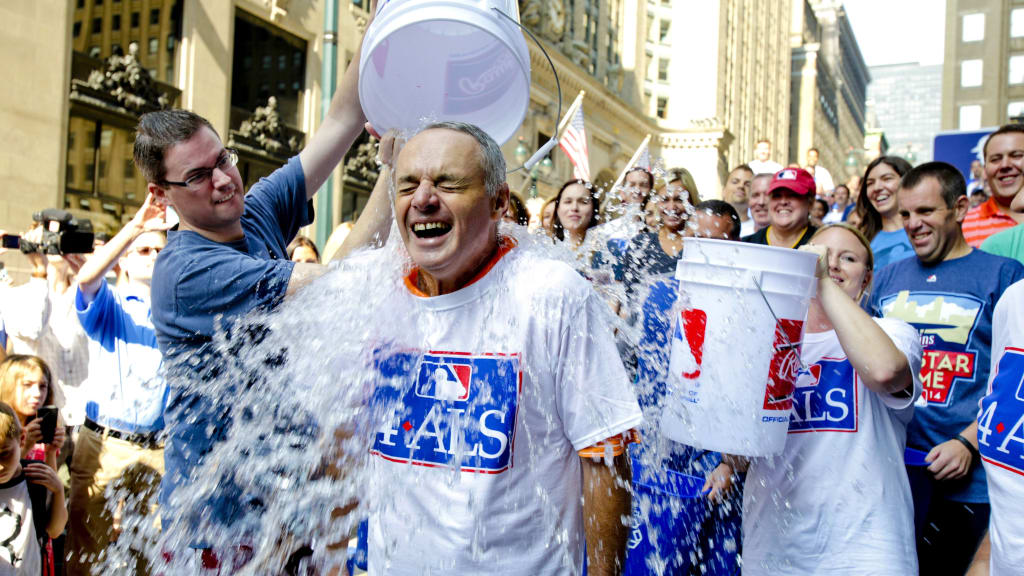It was the first Lou Gehrig Day in baseball on Wednesday. It was the great Iron Horse of the Yankees who first made the world aware of amyotrophic lateral sclerosis, known to the world now as Lou Gehrig's Disease. Of course Gehrig, on the day he retired from baseball because of a disease for which there is still no cure, gave the most famous speech any athlete has ever given, calling himself “the luckiest man on the face of the earth.”
Now, 82 years later, Major League Baseball honors not just Gehrig’s memory, but the ongoing fight to find a cure for ALS. He gave his speech at the old Yankee Stadium. So it was fitting that the family of a Boston College baseball player named Pete Frates, a young man whose life was taken by ALS at the age of 34, but became the face of a fund-raising and awareness-raising concept called the Ice Bucket Challenge before he left us, were invited to the new Yankee Stadium on Wednesday night.
Not only was the Frates family in the house, led by Pete’s parents, John and Nancy, so was Michael King, a Yankees pitcher who followed Pete Frates to Boston College and became his friend. Because even after Frates was diagnosed with ALS, and before the Ice Bucket Challenge became a worldwide phenomenon, BC coach Michael Gambino had made Frates his director of operations.
Pete Frates would travel with the team to weekend road series, sometimes on a team bus that had been outfitted with a wheelchair lift for the guy who had worn No. 3 for Gambino’s team, and who had once gone 4-for-4 against Harvard at Fenway Park and hit a home run into the visitors’ bullpen.
“What I mostly remember,” King said before Wednesday’s game, “is how awesome he was to be around, how big his personality was, even as he got weaker and weaker. And how hard he fought. He was determined to make an impact. And guess what? He finally did. I mean, who raised more awareness for his disease more than he did?”
It was because of the Ice Bucket Challenge, which to date has raised more than a quarter-of-a-billion dollars for ALS causes. It actually was started by another hero of the cause, a young man from Yonkers, N.Y., named Pat Quinn. The Quinn family was also represented at Yankee Stadium on Wednesday night, alongside the Frates family. It was only right; they were all in it together.
But it was Pete Frates, supported so tremendously by the Boston College community, who was most associated with the Challenge. Maybe because he was a ballplayer. Maybe it was as if he was the captain of one more team.
“I sometimes look back on the Ice Bucket Challenge,” John Frates said from a cab on his way to Yankee Stadium with Nancy, “as the last good thing the world did together.”
It seems so simple now: You made a video of yourself pouring ice water over your head, made your own contribution to ALS causes, and then you challenge a friend or acquaintance to do the same.
I nominated Joe Torre in a column in the New York Daily News, and before long, there were Joe and Commissioner Rob Manfred and the entire MLB staff down on the sidewalk in front of their Manhattan office, wearing T-shirts that had been made for that fine occasion that read “4 ALS,” the MLB logo proudly displayed above those letters. Then they all took the Ice Bucket Challenge on Park Avenue.

Gambino has one of those T-shirts framed in his office at Boston College. He said something to me on Wednesday that he had said to me before about Pete Frates, and about the Ice Bucket Challenge.
“I knew Pete’s teammates had always followed his lead, because I’d seen it with my own eyes,” Gambino said Wednesday. “I didn’t know that the whole world was going to do the same.”
There was a time when I was lucky enough to email with Pete Frates, thanks to a miracle known as eye-gaze technology. I asked him one day what it felt like watching the Ice Bucket Challenge raise the kind of money it was raising, and shine such extraordinary global focus on the cause to find a cure for the disease named after one of the greatest New York Yankees of them all.
“Hungry,” was Pete’s reply. “I will not be satisfied until we see this thing through. Incredibly thankful. Restored faith in God. I know why I’m here.”
He was diagnosed nearly three-quarters of a century after Lou Gehrig was. But now Pete Frates, whose life began to change when he was playing for a team called the Lexington Blue Sox in 2011 and a wrist injury was slow to heal, had joined the noble fight that Gehrig had begun, the fight that was officially honored by their sport on Wednesday, at Yankee Stadium and all across the baseball map.
Gehrig, No. 4 for the Yankees, was remembered on the other side of 161st Street in the Bronx from where he stood at the microphone on July 4, 1939. But so was a kid from Beverly, Mass., who wore No. 3 at Boston College.
There is a beautiful illustration in Frates Hall at Endicott College, in Pete’s hometown -- Gehrig and Pete Frates side by side, one photo in black and white, one in color, finishing what looks like the same left-handed swing. They look like teammates, frozen in time. And, once again last night at Yankee Stadium, maybe they were.
